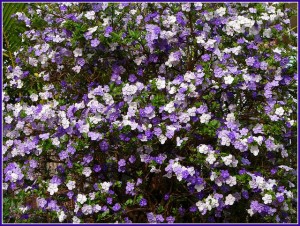Brunfelsias
 Question from Trinidad:
Question from Trinidad:
I just read on one of your books that Brunfelsias can take two shots of high nitrogen fertilizer in December and January. What kind of fertilizer do you recommend? Do I do a soil drench or spray on leaves?
I care for a garden that has approximately 100 of them. I would love to try this.
Answer from Pat:
I used to recommend using any synthetic liquid nitrogen fertilizer for this task but now that I have gone back to my roots as an organic gardener I think organic fertilizer is best since it causes less run-off. Blood meal is one organic nitrogen fertilizer that is strong and fast acting it contains iron also so it would be very beneficial to brunfelsias. No I would not spray the leaves, only drench the soil. I don’t know how large the plants are or how large the containers are in which they are growing, but maybe you could give each container one or two tablespoons of blood meal according to size and then water it thoroughly into the ground. Applying an organic, yucca-based wetting agent might help too since blood meal seems to shed water.


Thank you so much. The plants are all in the ground. I will use the
blood meal, since I prefer organic gardening.
Great news! You are doing exactly the right thing. I think you could apply more than two tablespoons per plant of blood meal since
the plants are in the ground. I hope you will let me know later how this works. Blood meal is a better idea than fish emulsion.
Unfortunately blood meal may attract animals. (It seems to attract dogs and cats and scare away rabbits.) Water it in well and
maybe cover over with mulch.
I have applied the blood meal on all Brunfelsias. I will keep you posted
on the outcome in June!
One more question, can I also use this blood meal to bring the dark
color on Camellia leaves? I have some that with only Camellia
fertilizer, still have yellow leaves. Please let me know.
Thank you so much.
Re: Brunfelsias. Sounds great and I look forward to hearing about results. Thanks so much
for writing again to give me news.
Re: Camellias: If yellow leaves on camellia have green veins the problem is not
a lack of nitrogen. The problem is a lack of iron and trace elements. This can happen if drainage is
poor and if the root zone is staying too soggy and wet. In this case the plant won’t be able
to take in the iron in the soil and the result is chlorosis (Yellow leaves with dark veins.)
The other possible cause is very sandy soil that contains insufficient iron.
To correct this problem apply chelated iron and trace elements according to package
directions. Or you could apply seaweed and a product containing humic acid such as
John and Bob’s Soil Optimizer. These also help cure chlorosis. If you have heavy clay
soil and you suspect drainage is a problem, apply gypsum according to package directions
and water it into the ground. Gypsum can gradually improve drainage if soil compaction results
from alkalinity.
All of the above can be applied right now, but this is not the correct time of year to be feeding
camellias with nitrogen. This is the time of year when camellias should be in full bloom.
Camellias are dormant during their winter bloom period. Fertilizing camellias now would
stimulate growth when the plant should be resting. However, once the plant has finished blooming
then it would be fine to fertilize it. Camellias should be fertilized three times a year,
during the warm months of the year. Feed them for the first time each year on
Memorial Day, then again one month to six weeks after that, and then a month after
that or on Labor Day. Use an acid organic commercial fertilizer recommended for camellias and azaleas.
Fertilizing with Blood meal would be a good addition if you think your camellias are in need of
additional nitrogen. However, if you want to follow the most famous way to feed them, cottonseed meal
is strongly recommended since it is acid. Camellias and azaleas usually do well on cottonseed
meal alone but it is best to apply it to the soil all over the root zone of the plant and this may
necessitate raking away the mulch, then applying the cottonseed meal and then replacing
the mulch and following up with water. If you apply the cottonseed meal on top of the mulch
the mulch itself uses much of the goodness of the organic fertilizer and it never reaches the
roots. If you apply organic fertilizer on top of mulch, use at least double the amount suggested on the
package since so little will reach the roots of the plant.